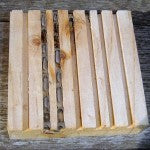Mason Bee or Mason Wasp- Pison spinolae
A familiar sound in Summer, is the high pitched buzzing of a female Mason Bee.
The female makes the cell, then collects spiders, which she paralyses , buzzing away happily while she works. Once the cell is packed with food supplies, she lays an egg & seals it shut. The egg hatches & the larva feeds on the preserved spiders. It’s a bit grim! Often we find empty cells with a hollow brown cocoon, which is all that’s left when the next generation emerge & fly away.
 The Mason Bee itself is quite demur, a small black insect, maybe 10 to 15mm in length. They are native to New Zealand. The high buzzing sound is often the first indication that you have a Mason Bees
The Mason Bee itself is quite demur, a small black insect, maybe 10 to 15mm in length. They are native to New Zealand. The high buzzing sound is often the first indication that you have a Mason Bees
 close by. , Providing a Solitary Bee House will hepl encourage them in the garden. A lot of people get their houses sprayed to kill spiders & other critters, & this probably makes the Mason Bee a less common visitor than it used to be!
close by. , Providing a Solitary Bee House will hepl encourage them in the garden. A lot of people get their houses sprayed to kill spiders & other critters, & this probably makes the Mason Bee a less common visitor than it used to be!
These cocoons are of the native mason wasp Pison spinolae, sometimes the insect is referred to as the mason bee,

 The Mason Bee itself is quite demur, a small black insect, maybe 10 to 15mm in length. They are native to New Zealand. The high buzzing sound is often the first indication that you have a Mason Bees
The Mason Bee itself is quite demur, a small black insect, maybe 10 to 15mm in length. They are native to New Zealand. The high buzzing sound is often the first indication that you have a Mason Bees
 close by. , Providing a Solitary Bee House will hepl encourage them in the garden. A lot of people get their houses sprayed to kill spiders & other critters, & this probably makes the Mason Bee a less common visitor than it used to be!
These cocoons are of the native mason wasp Pison spinolae, sometimes the insect is referred to as the mason bee,
close by. , Providing a Solitary Bee House will hepl encourage them in the garden. A lot of people get their houses sprayed to kill spiders & other critters, & this probably makes the Mason Bee a less common visitor than it used to be!
These cocoons are of the native mason wasp Pison spinolae, sometimes the insect is referred to as the mason bee, 
